Scholars offer solutions to cope with chunyun

Scholars have proposed measures to address difficulties with chunyun, or the Spring Festival travel rush. The 40-day transport frenzy kicked off on Feb. 4 and will last until March 16.
An estimated 0.28 billion trips are predicted to be made this year during chunyun as people head home for family reunions for the Chinese New Year, up 10.1 percent year-on-year.
Passenger flow during the travel rush has grown from last year, but this year’s focus has shifted from “difficulty in getting home” to “passengers’ higher demand for comfort and public safety,” said Wen Jun, a professor from the School of Social Development at East China Normal University in Shanghai.
Li Deyang, a professor from the School of Politics and Administration at Wuhan University of Technology (WUT), attributed problems arising during chunyun to the rural-urban divide.
As migrant workers flock to cities, regional imbalances and institutional obstacles have hindered their access to social resources and integration into modern city life, Li said.
To ease pressure triggered by the travel rush, scholars have proposed short- and long-term solutions.
In the short term, it is necessary to upgrade emergency management, augment traffic supply to rectify imbalanced traffic flow, and raise ticket fares and expressway tolls during the travel rush.
In the long term, the optimization of economic structure and introduction of a paid holiday system should be considered.
In recent years, China has advanced its high-speed rail construction. Nevertheless, it is difficult and risky to rely solely on a certain mode of transportation to resolve chunyun-related problems, so efforts should be made to bring the supporting and supplementary functions of other transportation modes into play, said Yang Jiaqi, a professor from the School of Transportation at WUT.
While allocating market resources efficiently, the government should mull a sound capacity reserve system to tackle passenger and traffic congestion, added Yang.

 PRINT
PRINT CLOSE
CLOSE